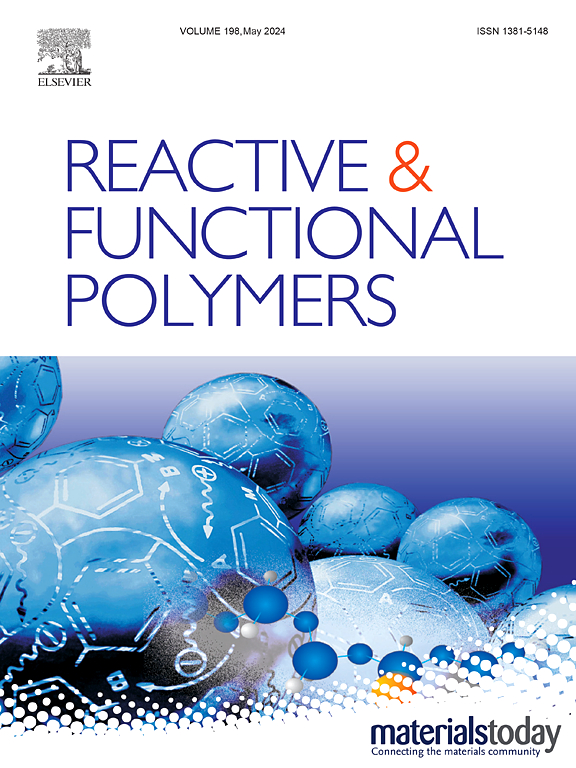Simultaneous toughening and strengthening of epoxy-anhydride thermosets using a glycidyl ether of eugenol-grafted polysiloxane without sacrificing thermal performance
IF 5.1
3区 工程技术
Q1 CHEMISTRY, APPLIED
引用次数: 0
Abstract
The brittleness of cured epoxy resin significantly impacts its reliability as an electronic packaging material. Researchers have consistently aimed to enhance its toughness without compromising the mechanical strength, glass transition temperature (Tg), and thermal stability. In this study, we initially synthesized a polysiloxane containing eugenol structure at the end and side chains through silicon‑hydrogen addition reaction. Subsequently, a glycidyl ether of eugenol-grafted polysiloxane (PMES-EP) was obtained by epoxidation using epichlorohydrin. For modifying the diglycidyl ether of bisphenol A (DGEBA)-based epoxy/anhydride thermoset, PMES-EP participated in the curing reaction, while had little influence on the curing process of the system. PMES-EP exhibited good compatibility with the epoxy system, and it improved the cross-linking density of the cured product, as well as introducing flexible polysiloxane chain segments into the network structure. Therefore, the addition of PMES-EP could effectively toughen and strengthen the epoxy/anhydride thermoset, meanwhile, maintain a high Tg and initial thermal decomposition temperature (Td5%). Compared with the pure epoxy thermoset, the PMES-EP modified epoxy thermoset with PMES-EP accounting for 20 wt% of DGEBA showed a 21.3 % and 58.8 % increase in tensile strength and impact strength, respectively, a 95.6 % retention in Tg, and no decrease in Td5%. Furthermore, the water contact angle test also revealed an enhancement of hydrophobicity of the epoxy thermoset by adding PMES-EP, due to the low surface energy of the polysiloxane chain structure. This study provides an effective strategy for toughening and strengthening of epoxy resin in electronic packaging field.

用丁香酚接枝聚硅氧烷的缩水甘油酯醚同时增韧和强化环氧酸酐热固性材料而不牺牲热性能
固化环氧树脂的脆性严重影响其作为电子封装材料的可靠性。研究人员一直致力于在不影响机械强度、玻璃化转变温度(Tg)和热稳定性的情况下提高其韧性。在本研究中,我们通过硅氢加成反应,初步合成了端链和侧链均含有丁香酚结构的聚硅氧烷。随后,以环氧氯丙烷为原料,经环氧化反应制备了丁香酚接枝聚硅氧烷缩水甘油酯。对于双酚A基环氧/酸酐热固性环氧二甘油酯的改性,PMES-EP参与了固化反应,但对体系的固化过程影响不大。PMES-EP与环氧树脂体系具有良好的相容性,提高了固化产物的交联密度,并在网络结构中引入了柔性的聚硅氧烷链段。因此,pes - ep的加入可以有效地增强环氧/酸酐热固性材料,同时保持较高的Tg和初始热分解温度(Td5%)。与纯环氧热固性树脂相比,PMES-EP添加量为20 wt%的DGEBA改性环氧热固性树脂的抗拉强度和冲击强度分别提高了21.3%和58.8%,Tg保持率提高了95.6%,Td5%没有下降。此外,水接触角测试还表明,由于聚硅氧烷链结构的低表面能,添加PMES-EP可以增强环氧热固性树脂的疏水性。该研究为环氧树脂在电子封装领域的增韧强化提供了有效的策略。
本文章由计算机程序翻译,如有差异,请以英文原文为准。
求助全文
约1分钟内获得全文
求助全文
来源期刊

Reactive & Functional Polymers
工程技术-高分子科学
CiteScore
8.90
自引率
5.90%
发文量
259
审稿时长
27 days
期刊介绍:
Reactive & Functional Polymers provides a forum to disseminate original ideas, concepts and developments in the science and technology of polymers with functional groups, which impart specific chemical reactivity or physical, chemical, structural, biological, and pharmacological functionality. The scope covers organic polymers, acting for instance as reagents, catalysts, templates, ion-exchangers, selective sorbents, chelating or antimicrobial agents, drug carriers, sensors, membranes, and hydrogels. This also includes reactive cross-linkable prepolymers and high-performance thermosetting polymers, natural or degradable polymers, conducting polymers, and porous polymers.
Original research articles must contain thorough molecular and material characterization data on synthesis of the above polymers in combination with their applications. Applications include but are not limited to catalysis, water or effluent treatment, separations and recovery, electronics and information storage, energy conversion, encapsulation, or adhesion.
 求助内容:
求助内容: 应助结果提醒方式:
应助结果提醒方式:


